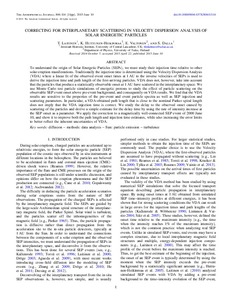Correcting for interplanetary scattering in velocity dispersion analysis of solar energetic particles
Huttunen-Heikinmaa K; Dalla S; Laitinen T; Valtonen E
https://urn.fi/URN:NBN:fi-fe2021042714617
Tiivistelmä
To understand the origin of Solar Energetic Particles (SEPs), we must study their injection time relative to other solar eruption manifestations. Traditionally the injection time is determined using the Velocity Dispersion Analysis (VDA) where a linear fit of the observed event onset times at 1 AU to the inverse velocities of SEPs is used to derive the injection time and path length of the first-arriving particles. VDA does not, however, take into account that the particles that produce a statistically observable onset at 1 AU have scattered in the interplanetary space. We use Monte Carlo test particle simulations of energetic protons to study the effect of particle scattering on the observable SEP event onset above pre-event background, and consequently on VDA results. We find that the VDA results are sensitive to the properties of the pre-event and event particle spectra as well as SEP injection and scattering parameters. In particular, a VDA-obtained path length that is close to the nominal Parker spiral length does not imply that the VDA injection time is correct. We study the delay to the observed onset caused by scattering of the particles and derive a simple estimate for the delay time by using the rate of intensity increase at the SEP onset as a parameter. We apply the correction to a magnetically well-connected SEP event of 2000 June 10, and show it to improve both the path length and injection time estimates, while also increasing the error limits to better reflect the inherent uncertainties of VDA.
Kokoelmat
- Rinnakkaistallenteet [19204]
